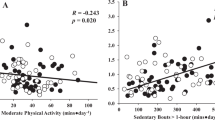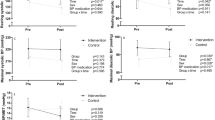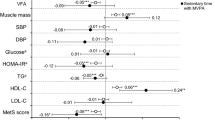Abstract
Sedentary behavior is an established risk factor for cardiovascular disease; however, it remains unclear whether sedentary behavior is associated with the deterioration of arterial blood pressure regulation. The purpose of this study was to determine the association between the time spent in sedentary behavior and cardiovagal baroreflex sensitivity (cBRS) in healthy adults. We investigated the cross-sectional relationship between sedentary time and cBRS in 179 adults aged 22–81 years. Sedentary time was objectively measured using a triaxial accelerometer. cBRS was evaluated by the transfer function gain of beat-by-beat changes in systolic blood pressure and the R-R interval during 5 min of spontaneous resting. Glycemic, lipidemic, and vascular risk factors were measured as potential covariates of cBRS and sedentary behavior. Men had a longer sedentary time and lower cBRS than women (p = 0.001). In a simple correlation analysis, older age was negatively associated with cBRS and positively associated with sedentary time, but sedentary time was not correlated with cBRS. However, after adjustment for age and sex, a longer sedentary time was associated with a lower cBRS. Multiple linear regression analysis showed that sedentary time was independently associated with lower cBRS with adjustment for covariates (β = −0.325, p = 0.002). A significant association was also confirmed when the analysis was performed separately in the younger and older groups. This finding suggests that high sedentary behavior may have an adverse effect on arterial blood pressure regulation.
This is a preview of subscription content, access via your institution
Access options
Subscribe to this journal
Receive 12 print issues and online access
$259.00 per year
only $21.58 per issue
Buy this article
- Purchase on Springer Link
- Instant access to full article PDF
Prices may be subject to local taxes which are calculated during checkout

Similar content being viewed by others
References
Lavie CJ, Ozemek C, Carbone S, Katzmarzyk PT, Blair SN. Sedentary Behavior, Exercise, and Cardiovascular Health. Circulation Res. 2019;124:799–815.
Tremblay MS, Aubert S, Barnes JD, Saunders TJ, Carson V, Latimer-Cheung AE, et al. Sedentary Behavior Research Network (SBRN) - Terminology Consensus Project process and outcome. Int J Behav Nutr Phys Act. 2017;14:75.
Ekelund U, Steene-Johannessen J, Brown WJ, Fagerland MW, Owen N, Powell KE, et al. Does physical activity attenuate, or even eliminate, the detrimental association of sitting time with mortality? A harmonised meta-analysis of data from more than 1 million men and women. Lancet. 2016;388:1302–10.
Pandey A, Salahuddin U, Garg S, Ayers C, Kulinski J, Anand V, et al. Continuous Dose-Response Association Between Sedentary Time and Risk for Cardiovascular Disease: A Meta-analysis. JAMA Cardiol. 2016;1:575–83.
Hadgraft NT, Winkler E, Climie RE, Grace MS, Romero L, Owen N, et al. Effects of sedentary behaviour interventions on biomarkers of cardiometabolic risk in adults: systematic review with meta-analyses. Br J Sports Med. 2021;55:144–54.
Young DR, Hivert MF, Alhassan S, Camhi SM, Ferguson JF, Katzmarzyk PT, et al. Sedentary Behavior and Cardiovascular Morbidity and Mortality: A Science Advisory From the American Heart Association. Circulation. 2016;134:e262–279.
Sagawa K. Baroreflex control of systemic arterial pressure andvascular bed. In: Handbook of Physiology, The Cardiovascular System, edited by Shepherd JT, Abboud FM. Bethesda: American Physiological Society. 1983. p. 453–496.
Schwartz PJ, Vanoli E, Stramba-Badiale M, De Ferrari GM, Billman GE, Foreman RD. Autonomic mechanisms and sudden death. New insights from analysis of baroreceptor reflexes in conscious dogs with and without a myocardial infarction. Circulation. 1988;78:969–79.
Gupta V, Lipsitz LA. Orthostatic hypotension in the elderly: diagnosis and treatment. Am J Med. 2007;120:841–7.
La Rovere MT, Pinna GD, Raczak G. Baroreflex sensitivity: measurement and clinical implications. Ann Noninvasive Electrocardiol. 2008;13:191–207.
Monahan KD, Dinenno FA, Tanaka H, Clevenger CM, DeSouza CA, Seals DR. Regular aerobic exercise modulates age-associated declines in cardiovagal baroreflex sensitivity in healthy men. J Physiol. 2000;529:263–71.
Monahan KD, Dinenno FA, Seals DR, Clevenger CM, Desouza CA, Tanaka H. Age-associated changes in cardiovagal baroreflex sensitivity are related to central arterial compliance. Am J Physiol Heart Circ Physiol. 2001;281:H284–289.
Monahan KD. Effect of aging on baroreflex function in humans. Am J Physiol Regul Integr Comp Physiol. 2007;293:R3–r12.
La Rovere MT, Bigger JT Jr., Marcus FI, Mortara A, Schwartz PJ. Baroreflex sensitivity and heart-rate variability in prediction of total cardiac mortality after myocardial infarction. ATRAMI (Autonomic Tone and Reflexes After Myocardial Infarction) Investigators. Lancet. 1998;351:478–84.
Pinna GD, Maestri R, Capomolla S, Febo O, Robbi E, Cobelli F, et al. Applicability and clinical relevance of the transfer function method in the assessment of baroreflex sensitivity in heart failure patients. J Am Coll Cardiol. 2005;46:1314–21.
Convertino VA, Doerr DF, Eckberg DL, Fritsch JM, Vernikos-Danellis J. Head-down bed rest impairs vagal baroreflex responses and provokes orthostatic hypotension. J Appl Physiol. 1990;68:1458–64.
Iwasaki KI, Zhang R, Zuckerman JH, Pawelczyk JA, Levine BD. Effect of head-down-tilt bed rest and hypovolemia on dynamic regulation of heart rate and blood pressure. Am J Physiol Regul Integr Comp Physiol. 2000;279:R2189–2199.
Iwasaki K, Zhang R, Perhonen MA, Zuckerman JH, Levine BD. Reduced baroreflex control of heart period after bed rest is normalized by acute plasma volume restoration. Am J Physiol Regul Integr Comp Physiol. 2004;287:R1256–1262.
Sobierajski FM, Purdy GM, Usselman CW, Skow RJ, James MA, Chari RS, et al. Maternal Physical Activity Is Associated With Improved Blood Pressure Regulation During Late Pregnancy. Can J Cardiol. 2018;34:485–91.
O’Brien MW, Al-Hinnawi A, Wu Y, Petterson JL, Shivgulam ME, Johns JA, et al. The Influence of Habitual Breaks in Sedentary Time on Cardiovagal Baroreflex Function. Appl Physiol Nutr Metab. 2021;46:1143–6.
Pinna GD, Porta A, Maestri R, De Maria B, Dalla Vecchia LA, La, et al. Different estimation methods of spontaneous baroreflex sensitivity have different predictive value in heart failure patients. J Hypertens. 2017;35:1666–75.
Ohkawara K, Oshima Y, Hikihara Y, Ishikawa-Takata K, Tabata I, Tanaka S. Real-time estimation of daily physical activity intensity by a triaxial accelerometer and a gravity-removal classification algorithm. Br J Nutr. 2011;105:1681–91.
Yoshioka M, Kosaki K, Matsui M, Takahashi K, Shibata A, Oka K, et al. Physical Activity, Sedentary Behavior, And Skeletal Muscle Strength In Patients With Chronic Kidney Disease: An Isotemporal Substitution Approach. Phys Ther. 2021;101:1–7.
Shibata A, Oka K, Ishii K, Miyawaki R, Inoue S, Sugiyama T, et al. Objectively-Assessed Patterns and Reported Domains of Sedentary Behavior Among Japanese Older Adults. J Epidemiol. 2019;29:334–9.
Zhang R, Iwasaki K, Zuckerman JH, Behbehani K, Crandall CG, Levine BD. Mechanism of blood pressure and R-R variability: insights from ganglion blockade in humans. J Physiol. 2002;543:337–48.
Xing CY, Tarumi T, Meijers RL, Turner M, Repshas J, Xiong L, et al. Arterial Pressure, Heart Rate, and Cerebral Hemodynamics Across the Adult Life Span. Hypertension 2017;69:712–20.
Yoshioka M, Tagawa K, Tochigi Y, Sato T, Park J, Momma R, et al. Central Blood Pressure in Young Kendo Athletes: Implications of Combined Anaerobic and Strength Training. Artery Res. 2021;27:87–92.
Fu Q, Ogoh S. Sex differences in baroreflex function in health and disease. J Physiol Sci. 2019;69:851–9.
Harron DW. Antihypertensive drugs and baroreflex sensitivity. Effects of rilmenidine. Am J Med. 1989;87:57s–62s.
Chen X, Hassan MO, Jones JV, Sleight P, Floras JS. Baroreflex sensitivity and the blood pressure response to beta-blockade. J Hum Hypertens. 1999;13:185–90.
La Rovere MT, Pinna GD. Beneficial effects of physical activity on baroreflex control in the elderly. Ann Noninvasive Electrocardiol. 2014;19:303–10.
Tanaka H, Tarumi T, Rittweger J. Aging and Physiological Lessons from Master Athletes. Compr Physiol. 2019;10:261–96.
Virani SS, Alonso A, Aparicio HJ, Benjamin EJ, Bittencourt MS, Callaway CW, et al. Heart Disease and Stroke Statistics-2021 Update: A Report From the American Heart Association. Circulation. 2021;143:e254–e743.
Dempsey PC, Larsen RN, Dunstan DW, Owen N, Kingwell BA. Sitting Less and Moving More: Implications for Hypertension. Hypertension. 2018;72:1037–46.
Padilla J, Fadel PJ. Prolonged sitting leg vasculopathy: contributing factors and clinical implications. Am J Physiol Heart Circulatory Physiol. 2017;313:H722–h728.
Taylor JA, Eckberg DL. Fundamental relations between short-term RR interval and arterial pressure oscillations in humans. Circulation. 1996;93:1527–32.
Porta A, Bassani T, Bari V, Pinna GD, Maestri R, Guzzetti S. Accounting for respiration is necessary to reliably infer Granger causality from cardiovascular variability series. IEEE Trans Biomed Eng. 2012;59:832–41.
James MA, Rakicka H, Panerai RB, Potter JF. Baroreflex sensitivity changes with calcium antagonist therapy in elderly subjects with isolated systolic hypertension. J Hum Hypertens. 1999;13:87–95.
Eguchi K, Tomizawa H, Ishikawa J, Hoshide S, Fukuda T, Numao T, et al. Effects of new calcium channel blocker, azelnidipine, and amlodipine on baroreflex sensitivity and ambulatory blood pressure. J Cardiovasc Pharm. 2007;49:394–400.
Ylitalo A, Airaksinen KE, Sellin L, Huikuri HV. Effects of combination antihypertensive therapy on baroreflex sensitivity and heart rate variability in systemic hypertension. Am J Cardiol. 1999;83:885–9.
Arzeno NM, Stenger MB, Lee SM, Ploutz-Snyder R, Platts SH. Sex differences in blood pressure control during 6° head-down tilt bed rest. Am J Physiol Heart Circ Physiol. 2013;304:H1114–1123.
Okazaki K, Iwasaki K, Prasad A, Palmer MD, Martini ER, Fu Q, et al. Dose-response relationship of endurance training for autonomic circulatory control in healthy seniors. J Appl Physiol. 2005;99:1041–9.
Fisher JP, Kim A, Hartwich D, Fadel PJ. New insights into the effects of age and sex on arterial baroreflex function at rest and during dynamic exercise in humans. Auton Neurosci. 2012;172:13–22.
Zhang R, Claassen JA, Shibata S, Kilic S, Martin-Cook K, Diaz-Arrastia R, et al. Arterial-cardiac baroreflex function: insights from repeated squat-stand maneuvers. Am J Physiol Regul Integr Comp Physiol. 2009;297:R116–123.
Horsman HM, Tzeng YC, Galletly DC, Peebles KC. The repeated sit-to-stand maneuver is a superior method for cardiac baroreflex assessment: a comparison with the modified Oxford method and Valsalva maneuver. Am J Physiol Regul Integr Comp Physiol. 2014;307:R1345–1352.
La Rovere MT, Specchia G, Mortara A, Schwartz PJ. Baroreflex sensitivity, clinical correlates, and cardiovascular mortality among patients with a first myocardial infarction. A prospective study. Circulation. 1988;78:816–24.
Sarma S, Stoller D, Hendrix J, Howden E, Lawley J, Livingston S, et al. Mechanisms of Chronotropic Incompetence in Heart Failure With Preserved Ejection Fraction. Circ Heart Fail. 2020;13:e006331.
Acknowledgements
This study was supported in part by the members of Seiji Maeda’s laboratory. The authors thank Ms. Michiru Hotta for her technical assistance.
Funding
This work was supported in part by a Grant-in-Aid for Scientific Research (KAKENHI) from the Ministry of Education, Culture, Sports, Science, and Technology, Japan (Grant number 19H03995). Shoya Mori was a recipient of a Grant-in-Aid for JSPS Fellows (Grant number 21J10952).
Author information
Authors and Affiliations
Corresponding author
Ethics declarations
Conflict of interest
The authors declare no competing interests.
Additional information
Publisher’s note Springer Nature remains neutral with regard to jurisdictional claims in published maps and institutional affiliations.
Supplementary information
Rights and permissions
About this article
Cite this article
Mori, S., Kosaki, K., Matsui, M. et al. Sedentary behavior is associated with reduced cardiovagal baroreflex sensitivity in healthy adults. Hypertens Res 45, 1193–1202 (2022). https://doi.org/10.1038/s41440-022-00904-5
Received:
Revised:
Accepted:
Published:
Issue Date:
DOI: https://doi.org/10.1038/s41440-022-00904-5
Keywords
This article is cited by
-
2023 update and perspectives
Hypertension Research (2024)
-
More moderate-intensity physical activity and less prolonged sedentary time are associated with better very short-term systolic blood pressure variability in healthy adults
Journal of Human Hypertension (2023)



